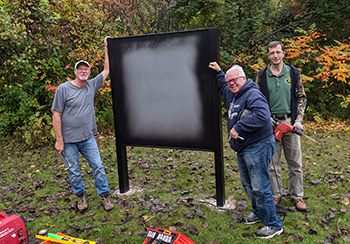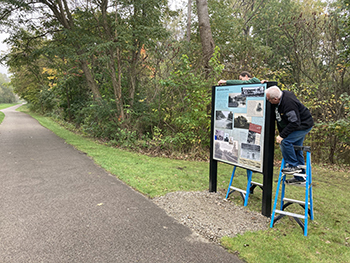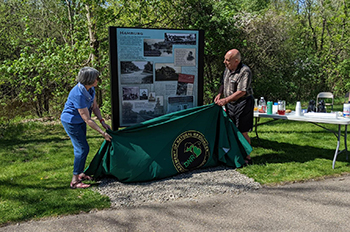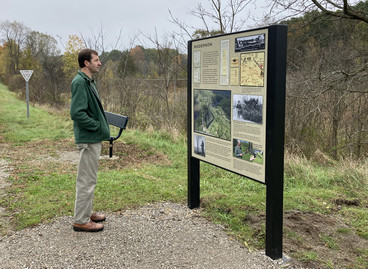Lakelands Trail connects Michigan history, outdoor recreation, communities
Explore Michigan's heritage trails
By DAN SPEGEL
Heritage trail coordinator, Michigan Department of Natural Resources
With more than 13,000 miles of state-designated trails that provide access for everyone to enjoy the great outdoors, Michigan is becoming known nationally as the “Trails State.”
Many of these trails are built on abandoned railroad corridors. These popular and safe pathways are fondly known as “rail-trails,” and Michigan has more miles of them than any other state.
Rail-trails tend to be long, linear trails that connect communities. They also have a fundamental connection to the past. Beginning in the mid-19th century, railroads were built through Michigan’s interior, creating a conduit for settlement and development.

Many of Michigan’s towns and cities, some of which are now gone, were established along these rail lines. This historical connection makes Michigan rail-trails a great place to discover our state’s early history.
This year, people enjoying the Mike Levine Lakelands Trail State Park, a 34-mile rail-trail in Livingston, Ingham and Jackson counties, will discover stories ranging from muck farmers growing onions to World War II German prisoners of war.
In November 2021, the Michigan Department of Natural Resources’ Heritage Trail Program installed 11 signs interpreting the natural and cultural history along the trail. This year, a 12th interpretive sign will be added once the trail is extended 3.7 miles to Blackman Township near the city of Jackson.
The Mike Levine Lakelands Trail is popular with locals and visitors looking to stretch their legs, ride a bike or simply enjoy the outdoors.
“While many areas of the trail are rural, they attract a huge variety of hikers, bikers and equestrians,” Nick Van Bloem, Michigan Department of Natural Resources trails specialist for southeast Michigan, said. “The variety of uses means it’s a great place to teach children how to ride a bike, train for a marathon, or ride your horse from your farm to the trails in Pinckney Recreation Area.”
The Lakelands Trail is also a backbone for trail connectivity in southern Michigan.
|

“The original trail has been expanded both east and west and will be the centerpiece for connections encompassing Jackson, Ingham, Livingston, and Oakland counties,” Van Bloem said. “It’s also a desired connection point as local municipalities add more regional trails.”
One ambitious project connecting trails is the Great Lake to Lake Trail Route #1. The 275-mile route unites individual local and regional trails from South Haven to Port Huron and includes the Mike Levine Lakelands Trail.
The trail’s namesake is local philanthropist Mike Levine. A longtime user and supporter of Lakelands Trail State Park, Levine generously provided the means to finish trail extensions and improvements. His support for trails also includes other segments of the Great Lake to Lake Trail Route #1.
“Mike set a goal to ride his bike across the state on this trail. Being the type of person who strives to solve problems he combined his persuasive and philanthropical traits to assist multiple communities along the route,” Van Bloem said. “The Mike Levine Lakeland Trail State Park now bears his name in recognition of his longstanding efforts.”
|

Since 2015, the DNR’s Michigan History Center has helped dozens of communities across the state identify and share their history through its Heritage Trail Program.
The addition of heritage interpretation enhances the trail experience by strengthening the connection between people and the place. It provides context and shares the stories that make a location special. It also makes the trail more appealing to people who value culture, and it creates new economic opportunities as it encourages people to explore the towns along the trail.
The Heritage Trail Program held the first Lakeland Trail community meeting for the interpretive sign project in December 2018, at the Hamburg Township Hall. Thanks to a grant from Levine, Josh Kaminski – then a graduate student in Eastern Michigan University’s Historic Preservation Program – worked on the project for two years, researching, gathering images and writing text for the signs.
“What I found to be most memorable was the amount of support and dedication that the community gave towards planning this,” Kaminski said. “People stepped forward with excitement and were eager to share their stories. That level of care is inspiring.”
The Mike Levine Lakelands Trail is not the first trail in Michigan to embrace history.
The Iron Ore Heritage Trail in Marquette County opened in 2008. Now 47 miles long, it connects communities forged in the heyday of Michigan iron mining. It provides dozens of interpretive signs, artifacts and artwork to share their story.
The Iron Ore Heritage Trail’s impact on the region inspired the DNR to create the Heritage Trail Program.
Michigan’s first rail-trail, the Haywire Grade, is also in the Upper Peninsula. To celebrate the Haywire’s 50th anniversary in 2020, the Heritage Trail Program partnered with the Manistique area community to create and install 11 customized interpretive kiosks and 34 mile-markers.
|

Another notable example is Kal-Haven Trail State Park. Opened to the public in 1989, the trail runs 34 miles between Kalamazoo and South Haven on a railroad corridor built in 1870.
In 2015, the Michigan History Center selected Kal-Haven to be the pilot project for the new Heritage Trail Program. This led to a three-year collaborative effort with the local community to identify and interpret the history along the trail.
The 2019 result was 31 interpretive signs, a mobile app designed for increased accessibility and a multi-sensory display.
“Ever since the installation of the Heritage Project on the Kal-Haven Trail, our guests will almost always comment on the panels they've seen along the way by saying, as we had hoped, ‘I had no idea this was here before,’" said Jeff Green, chairman of the Friends of the Kal-Haven Trail.
“Once the project was installed, we had an up-tick in traffic to our Facebook and web pages,” Green said. “We have also noticed a definitive increase in visitor traffic. Rarely does a busy day on the trail go by that we don't see guests stopping to read the heritage panels.”
Back on the Mike Levine Lakelands Trail, the new interpretive signs share the history of the land and the stories of people who once lived there. Trail users will cross over the Huron River, where they can learn about how it formed and the important role it played in the life of the Potawatomi.
Trail users will also get a glimpse of what life was like 140 years ago in communities including Stockbridge, Gregory, Hamburg and Munith. They will discover remnants of the railroad era and learn how it transformed the area in the 1880s.
Other stories told along the Lakelands Trail include those of novelist Mary Clavers, photographer Daisie Chapel, seasonal farm laborers and the Jackson prison.
The 12 new signs are in addition to five that the Motor Cities National Heritage Area had previously installed on the eastern section of the trail. With 17 interpreted historic stops, the trail is an outdoor recreation and cultural destination for all to enjoy.
Learn more about the Mike Levine Lakelands Trail, and the visit the DNR Heritage Trail Program at Michigan.gov/MHC/heritage-trails.
|
Check out previous Showcasing the DNR stories in our archive at Michigan.gov/DNRStories. To subscribe to upcoming Showcasing articles, sign up for free email delivery at Michigan.gov/DNR.
Note to editors: Contact: John Pepin, Showcasing the DNR series editor, 906-226-1352. Accompanying photos and a text-only version of this story are available below for download. Caption information follows. Credit Michigan Department of Natural Resources, unless otherwise noted.
Text-only version of this story.
Anderson: A man reads a heritage interpretive sign along the Mike Levine Lakelands Trail at the site where the village of Anderson once stood.
Frame: Three workers installing the frame for an interpretive sign along the Mike Levine Lakelands Trail in October 2021.
Map: Mike Levine Lakelands Trail Heritage interpretive site map.
Name: A Michigan Department of Natural Resources sign identifying the Mike Levine Lakelands Trail in Leoni Township is shown.
Panel: Two workers stand on ladders to install an interpretive sign for the Mike Levine Lakelands Trail in Hamburg.
Reveal: On May 14, 2022, Michigan History Center Director Sandra Clark and Mike Levine pull down a green Michigan Department of Natural Resources drape to reveal an interpretive sign during the heritage sign dedication ceremony at the Mike Levine Lakelands Trail trailhead in Hamburg.
Roots: Interpretive sign at the old Roots Station site along the Mike Levine Lakelands Trail in Leoni Township.
Seasonal: An interpretive sign about seasonal farm labor, located along the Mike Levine Lakelands Trail near Stockbridge, is shown.
|